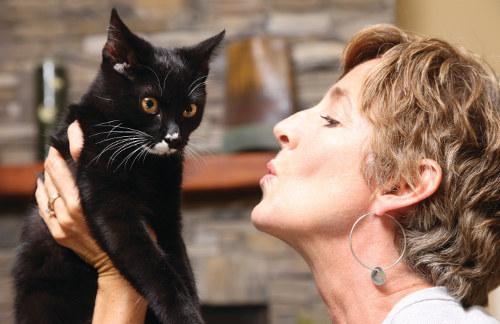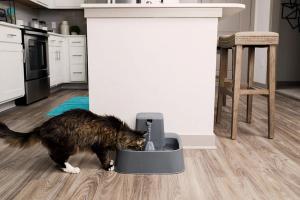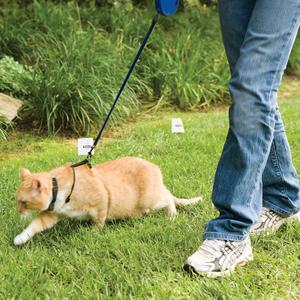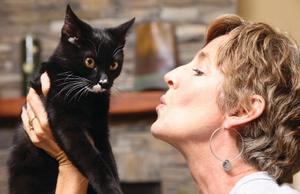January is National Train Your Dog Month, but don't forget about training cats. We expect our dogs to know basic manners, and rarely feel surprise if King offers a "sit" on command, or a paws-up to "shake" when asked. But folks guffaw at the mere mention of cat training.
How To Train Cats 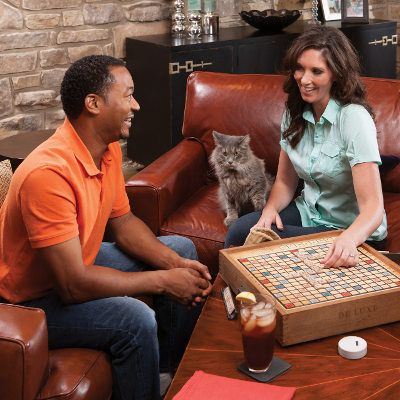 Actually, cats train as readily (or even more easily) than dogs. Just think of how quickly that kitten learns litter box etiquette from watching Mom, or figures out how to open the kitchen cupboard that holds catnip treats. During dog-drill exercises cats often begin to mimic the canines' sit-stay routine because they want in on the fun--cats come by the term "copycat" quite honestly.
Actually, cats train as readily (or even more easily) than dogs. Just think of how quickly that kitten learns litter box etiquette from watching Mom, or figures out how to open the kitchen cupboard that holds catnip treats. During dog-drill exercises cats often begin to mimic the canines' sit-stay routine because they want in on the fun--cats come by the term "copycat" quite honestly.
Why Train Your Cat?
Perhaps you wish to amaze doubting friends. High-energy felines find trouble when not given something to engage their busy brains, so some folks train Tabby out of self-defense to prevent feline marauders. But more than anything else, training and communicating with your cat enriches the bond you share, brings you closer together, and rewards you both immeasurably.
The trick to training Tabby lies in identifying natural behaviors, and then explaining to her THAT'S what you want by paying the cat for performing.
Doing What Comes Naturally
Anything Tabby does on her own becomes fair game to add to a "trick" repertoire. Make a list of the normal behaviors, as well as some of her odd foibles, to compile a trick list.
Common behaviors include sit, come, and speak since all cats do one or more of these things in their everyday life. Depending on the cat you might also add sit-up/beg, wave (cats always reach out with a paw!), or even fetch. Siamese kitties seem most inclined to enjoy retrieve games. Maybe you could promote his jumping ability and train him to leap through the circle of your arms.
Once you've identified possible behaviors, watch for when the cat naturally performs them. For example, often you can predict that Tabby always runs to the door when you return from work, or races to the food bowl for dinner. These habits can be used to train a reliable "come."
What Floats Your Cat's Boat? Give A Payday!
Dogs often relish verbal praise and perform for that alone. While cats also appreciate praise, more tangible rewards such as petting, toys or treats get the message across much more effectively. Cats crave different things, so figure out what floats your cat's boat and gets his purr a-rumbling.
Toys and games often work well. Pheasant feathers seem irresistible especially to kittens, and can be used to lure a particular behavior by snaking along the ground or waving for an outstretched paw to snare. Once you've figured out Tabby's favorite, reserve it for use only as a reward. Make her earn it before the games begin.
For food-motivated cats, treats work best for tempting and rewarding cats to perform a particular behavior. Offer something completely different than his usual diet that you reserve exclusively for training sessions. Commercial treats work well if the cat relishes them. Just break a single commercial cat treat into two or four pieces to make it last--you only need a nibble. If your cat usually eats dry kibble then choose tidbits of canned food for her treat reward.
Strong smelling treats work best. Offer something your cat loves--even people food such as meat baby food or deli smoked turkey breast can work--since you only need a tiny taste. For instance, my cat Seren nearly does back-flips for a taste of Philly cream cheese. A tiny smear on the end of my index finger provides her incentive to come when called, sit, sit up, and wave on command.
Kitty Cues & Clicker Training
Figure out a way to tell your cat you want to reward THAT (sit) behavior. Forcing a cat into the desired position or behavior doesn't work with felines. It's best to convince the cat it's his idea.
One of the most effective ways involves using a clicker that makes a distinctive sound to mark a particular behavior. You can also use your voice, but as we all know, cats sometimes learn to ignore our conversation. A clicker--or the click of a ballpoint, or snick of a stapler--provides a unique sound that teaches Tabby, "The click means I did something right."
Clicker training with cats works the same way as it does with dogs, horses, parrots or zoo animals. However, a cat's attention span is much shorter as is the feline appetite. While a dog might be willing to engage in training for 20-30 minute shifts, a cat often has had enough in five minutes (or 5 to 10 treats/rewards).
Cat Training 101
Watch for Tabby to perform (on her own, at her leisure) one of the behaviors you've identified. Perhaps she's walking across the living room, then stops at the window and sits--as her furry bottom hits the carpet, you CLICK! and then immediately produce her reward of choice (treat, toy, scritches).
She's likely to get up and mew or solicit more treats, and you ignore her until/unless she again happens to sit CLICK! she gets another reward. Very often by the time the cat hears a third or fourth CLICK followed by a treat (or feather or other reward), she puts it together that if she sits--you CLICK and pays her for the behavior.
This first lesson may take the longest, but once Tabby figures out the CLICK communicates your approval, she'll look for other ways to earn a reward and your positive attention. You can put clicker training, bribes, and luring to work to teach cats several behaviors. Here are a couple more to get you started.
Here Kitty Kitty Kitty...Teaching COME
Cats easily train themselves to come when called at dinner time. They associate the sound of kibble in the bowl, or the whirrr of the can opener and come running for this cue. Use that natural behavior to train Tabby.
Use the command "come!" each time you fill his bowl, and when he arrives, CLICK and then offer his dinner. Do this faithfully for a couple of weeks to associate the word COME with being fed and a bonus reward.
Next, load your pockets with his favorite treat or toy and give the "come!" command at another time, from a different place in the house. When he arrives, CLICK and give him his reward. Repeat the exercise for another two weeks.
Finally for the next couple of weeks practice the "come!" at both mealtimes and at different times and places, and CLICK each time but only give him a treat every third or fourth time. This teaches Kitty that he'll almost always get a treat when he comes--he never knows when for sure, so he'll be more likely to respond every time on the chance he'll get the reward. Intermittent rewards can be a powerful incentive.
Once your cat learns how to come when called avoid using this command for any negative reason. In other words, if you must clip claws, take her to the veterinarian, or chastise her, simply go collect the cat rather than ask her to come. Otherwise you risk teaching Tabby that COME means she'll have something nasty done to her person, and she'll quickly un-learn the behavior.
Sitting Pretty: Lure Training
Use Tabby's favorite treat, or toy. Pheasant feathers work great for this. Rather than waiting for the cat to sit on her own, you can lure the behavior and then reward Tabby with the CLICK and treat.
With the cat standing before you hold the feather or treat directly over her head, and slowly move it backwards. In order to follow the lure with her eyes and not fall over, Tabby must plant her tail.
As soon as touch down takes place, time your "sit!" command and CLICK to coincide with the action, then reward with the treat or access to the feather. Some cats, like my Seren, will learn to run to you and sit down just to see if they can get their own personal "treat machine" to pay up!
Say Howdy and Beg
You can easily teach a "howdy" wave from the sitting position. Cats naturally reach out with paws to grab enticing objects, so use the feature lure or treat to tempt the cat to "wave" with one or the other paw. Most cats have a dominant (right paw, left paw) they'll offer first. Remember to time your CLICK and treat appropriately to explain/communicate to the cat exactly what you're looking for.
A "beg" position with both paws up comes more naturally to some cats than others. Much depends on Tabby's body conformation, with overweight or out of shape cats more challenged. Cats who perform this behavior naturally may learn the trick readily simply by you holding the treat or feather toy slightly above her head while she's in a seated position. CLICK and treat reward any attempt at first, even if at first she can't keep her balance. With practice she'll improve, and do you both proud.

